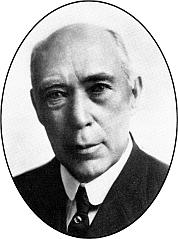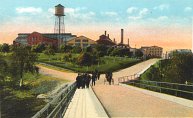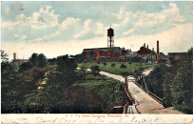|
Up: Insulators |
H. C. Fry Glass Co. Home > Insulators > Fry |
Ref: 5 of 15 |
|
Up: Insulators |
H. C. Fry Glass Co. Home > Insulators > Fry |
Ref: 5 of 15 |
 Henry Clay Fry


 Fry ovenglass catalogue #4 JPG ~17MB: tar|zip|pdf PNG ~181MB: tar|zip|pdf |
The H. C. Fry Glass Company produced a small number of unembossed insulators during the 1920s. Few were sold (presumably due to uncompetitive pricing) and even fewer survived, making all Fry insulators very rare today.
The four pin-type insulators, CDs 164.4, 229.6, 299.2, and 301.2, were all designs unique to Fry. They were made in four opalescent colors (black, white, green and cobalt blue), dark green, green blackglass, straw and an opaque cobalt blue. The CD 164.4 (right) is the most common style, especially in black opal, of which a number of damaged specimens recovered from the factory dump now circulate in the hobby. In mint condition, a white opal 164.4 is worth $5,000+; in black opal, less than $1,000. Fry also produced a set of experimental suspension insulator discs, though they were never mated with metal hardware. All were eventually ordered to be dumped, but the man tasked with the job saved the one complete disc that now remains. I have fragments of a second disc (below right). In the early 1900s, at the close of the Victorian era, cut and etched class was on the decline. In response, Fry decided to enter the field of domestic glass, especially kitchenware. The first pieces were made in 1915 in a lime crystal glass, and were tested by residents in the Rochester (New York) area. The glass kitchenware was very successful, and demand increased steadily. Fry is best known today for their complete line of heat-resisting borosilicate "ovenglass" in an opal color (called "pearl" at the factory), which started production in 1921. Motto: "A shape for every oven use." The addition of boron to the glass batch results in an article with low thermal expansion which can survive sudden temperature changes: "Fry Ovenglass has twice the strength and more than twice the thermal endurance of other glass." But it is not magic: "When removing this glass from the oven use a dry cloth. Fry Ovenglass is made to stand sudden changes from hot to cold or vice-versa, but reasonable care should be exercised." Fry's higher-end line of tableware and art glass using the same opalescent formula, often with contrasting details, was trademarked as Foval (Fry OVenglass Art Line). Less known but equally desirable are their offhand art glass pieces, and earlier cut and etched glassware. The H. C. Fry Glass company survived the Great Depression, but not for long: they were in receivership in 1925, and when H. C. died in 1929 the company was reorganized, but they shut down for good in 1933. Many pieces of Fry glass remain today, especially their ovenglass line, a durable and practical product that is as popular today as when first made. |